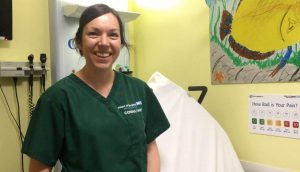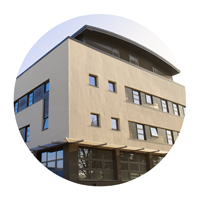 The merger by acquisition of Birmingham’s two largest hospital trusts is to go ahead on 1 April 2018.
The merger by acquisition of Birmingham’s two largest hospital trusts is to go ahead on 1 April 2018.
Plans to bring together University Hospitals Birmingham NHS Foundation Trust – which runs the Queen Elizabeth Hospital Birmingham – and Heart of England NHS Foundation Trust, which manages Heartlands, Good Hope and Solihull hospitals, have been given the green light from the trusts’ respective Boards of Directors, with the decision cleared by both Councils of Governors.
The enlarged organisation will use the University Hospitals Birmingham NHS Foundation Trust name (UHB). All individual hospital and clinic names will remain the same, including the Birmingham Chest Clinic.
The single Trust will have approximately 50,000 Foundation Trust members and employ more than 20,000 members of staff. It will be one of the largest trusts in England treating over 2.2 million patients each year, with more than 2,700 beds across its sites and an estimated annual turnover of £1.6 billion.
The Rt Hon Jacqui Smith, Chair of UHB and interim Chair of HEFT, said: “The final approval to combine the two trusts is the result of a huge amount of preparation and planning to ensure the new organisation can provide the best possible healthcare to the population we serve.”
Dame Julie Moore, Chief Executive, UHB and interim Chief Executive at HEFT, said: “The combined expertise of the two trusts will benefit all of our patients and bring added benefits to the local health economy that could not be otherwise achieved.”
The merger by acquisition, proposed in September 2016, had been under consideration by the government’s Competitions and Markets Authority for several months before being cleared in August 2017.
The CMA concluded that, while the merger could give rise to competition concerns across a number of elective specialties, these were outweighed by the substantial improvements to patient care that were expected to arise.
In reaching this view, the CMA placed significant weight on the advice on probable benefits from NHS Improvement, the sector regulator, which strongly supported the merger.
NHS Improvement advised the CMA that HEFT had experienced sustained difficulties in governance, quality of care and finances since 2012, which successive management teams had been unable to address.
It also advised that the appointment of the UHB management to HEFT’s executive team in October 2015 had already given rise to a number of benefits, such as reduced waiting times and improvements in the quality and safety of patient care for all HEFT patients. However, these improvements and a number of other longer-term benefits would disappear without the merger and the continued presence of the UHB management at HEFT.
The CMA found that HEFT would be a relatively weak competitor to UHB without the merger and that both parties were experiencing capacity constraints.
The CMA compared this to the wide-ranging nature of the benefits identified by the hospitals and NHS Improvement, which would benefit most patients at HEFT. It also examined UHB’s track record and the results already delivered at HEFT since October 2015.
NHS Improvement also needed to approve the application following the clearance from the CMA.
It conducted a thorough review of the proposed transaction, assessed the business case and issued an indicative transaction risk rating of Amber, which was expected, and sufficient to enable the Boards to undertake the transaction.
The merged organisation, approved at extraordinary meetings of both trusts’ boards on Monday (Monday March 26) will deliver services to patients in Birmingham, Solihull, Sutton Coldfield and South Staffordshire. It will aim to deliver more equitable patient access to better quality and integrated healthcare across the footprint of the new merged Trust, through Heartlands, Good Hope, Solihull and the Queen Elizabeth hospitals.
 Catrin (Cat) is an emergency department consultant who works across our three hospitals.
Catrin (Cat) is an emergency department consultant who works across our three hospitals.
Cat, who is accredited in paediatrics, is on her second spell working for us. She says she rejoined in October 2016 – and say that largely because of the great people in the ED team.
She is originally from South Wales and moved to the Birmingham area 15 years ago. She finished all her training 12 months ago and currently lives in Worcester which is about an hour’s commute.
“I really enjoy the work. I like the fact that we see everything… you just don’t know what’s going to come in from day to day.
“Although we are always looking for new consultants we still have 21 of us working here at the moment and when there’s so many there’s always opportunities to do things and learn from others. There’s always research projects going on. We’ve all got our little areas of interest so there’s always opportunities for things such as teaching.”
1. What Patient Administration System do you use?
We have two systems that make up our PAS system – PMS2 (in-house) and UltraGenda.
2. Who is your supplier for Electronic Health Record/ Electronic Patient Record?
Our EPR is managed In–house, and is called Concerto and I-care.
3. What system do you use for Oncology.
The System used are Bookwise and Dendrite.
1. The income earned from hospital car parking charges for the financial years:
1. 2014-2015
2. 2015-2016
3. 2016-2017
This information is available on the Trust’s website at at FOI 5514. We are therefore withholding this information under Section 21 of the Freedom of Information Act 2000 “information already accessible “.
2. The money spent on maintenance for car parking facilities in the financial years:
1. 2014-2015
£1,165k
2. 2015-2016
£1,064k
3. 2016-2017
£1,066k
3. Where the income earned from hospital car parking facilities was spent in the financial years:
1. 2014-2015
2. 2015-2016
3. 2016-2017
Please see attached spreadsheet.
I would like to know what food items were bought by the doctors’ mess at your hospital during their last/most recent shop. Usually doctors’ messes buy food once a month. Please send me an itemised list or a copy of the receipt.
We do not hold this information.
1. Please could you give me the list of who is on the drugs and therapeutics Committee? Their names and what their roles are ?
Charalampos Kartsios – Consultant Haematology (chair)
Tania Carruthers – Clinical Director of Pharmacy
Carol Evans – Interfacing Prescribing Manager
Yogita Chikermane – Consultant Anaesthetics
Gurdeep Chopra – Principal Pharmacist – Clinical Effectiveness & Medication Safety
Katy Davies – Pharmacist – Medicines Information
Kavita Gopee – Nurse
Scott Hackett – Consultant Paediatrics/Neonates
Natasha Jacques – Principal Pharmacist – Specialised Medicine & Community Services
Karen Ennis – Assistant Head of Medicines Management CCG
Nilima Rahman-Lais – Deputy Head of Medicines Management CCG
Caroline Maynard – Faculty Nurse Educator
Shahzad Razaq – Principal Pharmacist – Medicine and Anti-Infectives
Ellen Shirley – Principal Pharmacist – Cancer Services
Vijayan Suresh – Consultant Renal
Su Dorrian – Consultant Emergency Department
Rachel Ferreday – General Manager Division 1
2. Also please could you let me see the minutes of the last drugs and therapeutics meeting?
Please find the attached PDF document.
1. Please provide the number of funded Doctors in training posts you have split by specialty?
Please see attached spreadsheet.
2. Could you split these numbers by those provided by the Deanery and funded internally by the Trusts own training programme.
Please see attached spreadsheet.
3. Please reveal the number of Rota vancancies split by specialty
Please see attached spreadsheet.
. Within your health trust how many patients are currently [within the past 6 months available] being treated for head and neck cancer (Squamous cell carcinoma)?
Please see below response.
2. Of these patients how many are locally advanced and how many are recurrent and/or metastatic head and neck cancer patients?
a. Locally advanced
b. Recurrent metastatic
Please see below response.
3. Of the locally advanced/ recurrent or metastatic head and neck cancer patients how many are currently [within the past 6 months available]
Carboplatin (only or in combination with 5-FU)
Cisplatin (only or in combination with 5-FU)
Cetuximab (Erbitux) with/without chemotherapy
Cetuximab (Erbitux) with radiotherapy
Docetaxel (Taxotere) -only or in combination with 5-FU
Fluorouracil (5FU)
Radiotherapy only
Other
Please see below response.
4. Does your health trust participate in any ongoing clinical trials for the treatment of head and neck cancer patients, if so how many patients are currently taking part in clinical trials?
Please see below response.
5. Within your health trust how many patients are currently [within the past 6 months available] being drug treated for metastatic colorectal cancer?
Of those patients please split by their drug treatment;
Cetuximab (Erbitux) with/without chemotherapy
Panitumumab (Vectibix) with/without chemotherapy
Nivolumab (Opdivo) with/without chemotherapy
Chemotherapy + other mAb
Chemotherapy alone
Other
Please see below response.
6. Does your health trust participate in any ongoing clinical trials for the treatment of colorectal cancer patients, if so how many patients are currently taking part in clinical trials?
All patients diagnosed with head and neck cancer treated with chemo/radiotherapy receive this at UHB. UHB are the head and neck cancer centre and this information would be held by them
1. Do you currently offer a biomarker testing for the following, as of the beginning of 2018?
PD-L1 in NSCLC
Yes, in house service
Yes, but send out PD-L1 testing to another laboratory
(Please specify which laboratory samples are sent to:____________)
No, and do not send to another laboratory
ALK in NSCLC
Yes, in house service
Yes, but send out ALK testing to another laboratory
(Please specify which laboratory samples are sent to:____________)
No, and do not send to another laboratory
BRAF in Melanoma
Yes, in house service
Yes, but send out BRAF testing to another laboratory
(Please specify which laboratory samples are sent to: University Hospital Birmingham)
No, and do not send to another laboratory
2. Is predictive biomarker testing conducted at the same lab (or similar location such as in same building) as the initial cytological and histological (H&E stain) assessment, or is this done at a different site?
IHC
Yes, done at same lab or site
No, sent to another lab or site
(Please specify which laboratory samples are sent to:____________)
FISH /ISH/ NGS / PCR
Yes, done at same lab or site
No, sent to another lab or site
(Please specify which laboratory samples are sent to: please note except NGS)
3. Is biomarker testing performed reflexively or upon request for the following biomarkers?
PD-L1 in NSCLC
Reflexively (i.e. prior to starting 1L treatment)
Upon request (i.e. case by case after disease progression)
If reflexively – What is the laboratory protocol for PD-L1 testing in lung cancer patients
Multi-marker panel (i.e. multiple biomarkers, one test)
Sequential single gene (i.e. one biomarker, one test)
Other (Please specify____________)
ALK for NSCLC
Reflexively (i.e. prior to starting 1L treatment)
Upon request (i.e. case by case after disease progression)
If reflexively – What is the laboratory protocol for ALK testing in lung cancer patients
Multi-marker panel (i.e. multiple biomarkers, one test)
Sequential single gene (i.e. one biomarker, one test)
Other (Please specify____________)
BRAF in Melanoma
Reflexively (i.e. prior to starting 1L treatment)
Upon request (i.e. case by case after disease progression)
If reflexively – What is the laboratory protocol for BRAF testing in melanoma patients
Multi-marker panel (i.e. multiple biomarkers, one test)
Sequential single gene (i.e. one biomarker, one test)
Other (Please specify____________)
4. Which of the following biomarkers are assessed in lung cancer patients in your laboratory? (please select all that apply)
ALK
EGFR
ROS1
DLL3
PDL-1
5. Which of the following testing platforms are used at this this laboratory? (please select all that apply)
FISH
NGS
PCR
IHC
Other
6. What IHC staining platform(s) are used in the laboratory for biomarker testing? (please select all that apply)
Ventana
Dako
Leica
Other (If possible, please supply the model of the platform_________)
7. What type of test does the institution prefer to use for biomarker-predictive IHCs?
IVD CDx (commercial)
LDT (lab developed)
None
What is the main factor in this decision?
Funding constraints
Control over methodology
Other (Please specify quality and standardisation___)
8. Does your lab / trust seek separate reimbursement from NHS under the “high-cost medicines and tests” provision for biomarker tests that have been excluded from tariff?
Yes
No
9. What is the number of samples being tested (or sent-out) are tested for the following biomarkers?
ALK
Please specify number: 20 (per month)
EGFR
Please specify number: 20 (per month)
PD-L1
Please specify number: 24 (per month)
BRAF
Please specify number: 3 (per month)
10. Where are archived tissues from lung cancer patients stored?
On-site
Off-site
11. If on-site; how long are tissues stored on site until transferred to other storage facility?
Never
<1 yr
1-2 yrs
>2 yrs
12. What is the typical turn-around time from tissue/specimen extraction to the report of biomarker testing results in lung cancer patients?
<1 week
1 – 2 weeks
>2 weeks
13. How are the following biomarker testing funded at your lab?
Local funding (financed through pathology / lab budget)
Pharma funded initiative, please specify details
Individual funding through high cost medicines and procedures provision
Unsure
1. Total patient population covered by the trust overall.
1.2 million
2. The total patient population covered by the trust in 2017 only.
1.2 million
3. HEFT Adult Audiology Attendances/ DNAs by Ethnic Group, Gender and Age Group (just for time period Jan – Dec 2017) (please see excel sheet attached).
I have attached an example excel table to try and make it easier to understand the data I require. If the table can be filled for the year 2017 (Jan-Dec) that would be all the data I need.
Please find attached spreadsheet.






